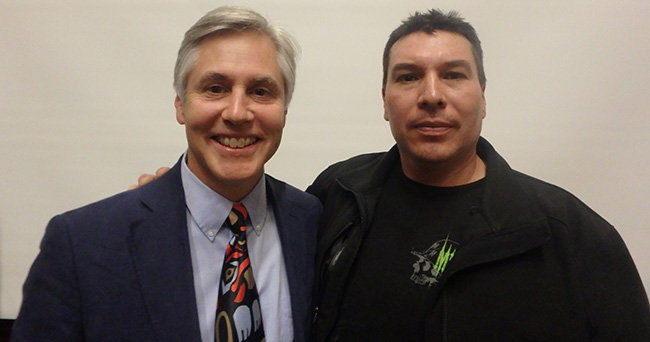The Seven Grandmothers: Professor John Borrows speaks on Anishinaabe Teachings and Canadian Constitutional Law

By Laura Robinson
TORONTO – From October 16-18, by 4:00 pm, Room 140 at University College within the University of Toronto, quickly filled.
John Borrows, of the Chippewa of Nawash, and now the Canada Research Chair in Indigenous Law at University of Victoria, used Anishinaabe laws of Love, Truth, Bravery, Humility, Wisdom, Honesty and Respect to critique the Canadian Constitution and how it has been used in Canadian Supreme Court decisions. For anyone who thought they were coming to hear a scholar speak dryly about common law, or the great-great grandson of an Anishinaabe chief speak romantically of a by-gone era, they soon realized thinking caps and open hearts were necessary in equal amounts. As advertised by U of T, these three lectures were quite literally a “History of Ideas”—big ideas, but delivered, as Borrows noted, sometimes not by the eagle or the buffalo, or great fish, but by the mole—the small animal who could observe a great deal from his vantage point of burrowing through the Earth, and seeing what the large animals could not.
He advises the animal council, as they try to decide on the journey on which the human-being will be sent.
“The gift we will give is the one that goes inside. It’s hard to look inside and when humans do the work, it will be hard because the greatest distance humans will ever travel is done between the head and the heart.” Borrows adds that it is the braiding of Western Law, that imagines itself to be from the head (he also argued that it is subconsciously treated like a sacred religion by many), and Aboriginal Law that will bring us to a new understanding of what it means to be a human-being.
Borrows told the story of mole as part of his first story about a young girl, who wandered the Earth to learn about “being a good person in the world”. She learned to set “a path to the river, the escarpment, the forest and lake and to all the living things there. And from these professors she was told stories. She heard their stories along with stories from elders, aunts and uncles. She would learn patterns of behaviour, teachings, including knowing that people are both beautiful and messed up”. The girl would meet an otter, who would become her mentor, Borrows told the room, in which sat many professors of a different nature. When he finished the story with mole’s advice of “traveling from the head to the heart”, he had introduced the Seven Grandmother teachings—now he would explain how these teachings are foundational Anishinaabe laws.
Borrows went onto explain the meaning of the Wampum belt, especially in the context of treaties. In many ways, if it is interpreted in the way in which it is meant, a Wampum belt could be considered as a first Constitution. It illustrates the relationship that entangles (Borrows argues this word has many meanings, not all of which are negative) because “rights were formed from the meeting of two cultures” characterized through the story told through the belt, and the words of the treaty.
Borrows emphasized that presently Canada uses common-law and legislated law, and that Section 35(1) of the Constitution—which recognizes and affirms Aboriginal treaty rights—has as its ultimate goal reconciliation. The real challenge for those who care deeply about the Seven Grandmother Teachings and deeply about reconciliation, will be to test the Constitution and see if it holds up as a true reconciliation vehicle, thus creating more common-law that understands and could possibly embrace Aboriginal law.
But how can a Constitution be tested? Through the creative and meaningful “entanglement” or “braiding” of Aboriginal law and Western law into exciting, new, but sound legal arguments. If the Constitution is a living document, then the interpretation of what it means will change as the courts and government start to understand the meaning and importance of Indigenous Laws. “We have a set of obligations to care for one another—morally, politically—these are defensible rights. Treaties are negotiations” said Borrows about Indigenous people and settlers. He argued that both cultures bring a set of values that matter to the negotiating table. It will be through the search for common values, and the stretching of non-Indigenous people’s understanding of the validity of laws that existed well before Europeans arrived that will be the platform for change.
Borrows took his audience one step further and asked if reconciliation—especially if it’s derived through successful legal challenges using Aboriginal law to expand the meaning of the Constitution—could actually be love—one of the Seven Grandmother teachings? “How can law be love?” he asked. How do we make love a legal principle?”
He made it clear that he wasn’t talking about love in a quaint or popular understanding of the word, or in a “vague” sense, and pointed out there are many words in Western law that are equally loaded and vague, but rather as something deeply embedded in meaning and actions. Love doesn’t exist in isolation of the other Grandmother teachings; if love is to be expressed—particularly in law–it must be done with respect, in truth and honesty, be both brave and humble, and exercised with wisdom.
To weave the Seven Grandmother teachings into arguments that challenge Canadian law, Borrows recommends to “Look for frameworks, best practices—how are those best practices determined? We have a Duty of Care to one another—a Duty of Care that arises from principles of law—what is reasonable?” This award-winning professor (https://www.thelawyersdaily.ca/articles/3087/university-of-victoria-scholar-borrows-wins-national-killam-prize?article_related_content=1 ) poses at least as many questions as he answers.


